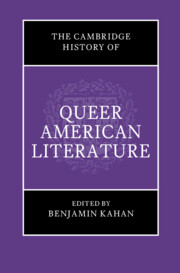Book contents
- The Cambridge History of Queer American Literature
- The Cambridge History of Queer American Literature
- Copyright page
- Contents
- Figures
- Tables
- Contributors
- Acknowledgments
- Introduction
- Part I Synchronic Histories of American Sexuality
- Part II Diachronic Histories of American Sexuality
- Queer Genre
- Race and the Politics of Queer and Trans Representation
- Space and the Regional Imaginary of Queer Literature
- 33 Queer Southern Literature and the Dirty South
- 34 Queer DiaspoRican Circuits
- 35 “where sadness makes sense”
- 36 Queer New England Regionalism
- 37 Queer Beginnings at the End of the Frontier
- 38 Queer American Literature in the World
- Part III Queer Methods
- Index
34 - Queer DiaspoRican Circuits
from Space and the Regional Imaginary of Queer Literature
Published online by Cambridge University Press: 17 May 2024
- The Cambridge History of Queer American Literature
- The Cambridge History of Queer American Literature
- Copyright page
- Contents
- Figures
- Tables
- Contributors
- Acknowledgments
- Introduction
- Part I Synchronic Histories of American Sexuality
- Part II Diachronic Histories of American Sexuality
- Queer Genre
- Race and the Politics of Queer and Trans Representation
- Space and the Regional Imaginary of Queer Literature
- 33 Queer Southern Literature and the Dirty South
- 34 Queer DiaspoRican Circuits
- 35 “where sadness makes sense”
- 36 Queer New England Regionalism
- 37 Queer Beginnings at the End of the Frontier
- 38 Queer American Literature in the World
- Part III Queer Methods
- Index
Summary
The history of queer and trans Puerto Rican and Diasporican literature is complex. Its relationship to American literature is fraught with issues of colonialism and linguistic exclusion. Careful analysis of a wide-ranging corpus from the late 19th and early 20th centuries by Alejandro Tapia y Rivera (1882), José de Diego Padró (1924), and Pedro Caballero (1931), reveals a longstanding interest in queer and trans experience in works written in Spanish in Puerto Rico and New York. The massive social transformations of the 1960s and 1970s led to the explosion of critical voices such as those of Luis Rafael Sánchez, Manuel Ramos Otero, and Luz María Umpierre. Their pioneering texts, and the complex writing of Nuyorican authors in English, opened the way for late 1990s and early 2000s authors such as Ángel Lozada and Mayra Santos-Febres, for the eventual creation of collectives such as Homoerótica in 2009, and for the widespread acclaim of writers such as Luis Negrón, Yolanda Arroyo Pizarro, Justin Torres, and Raquel Salas Rivera. “Queerness,” as such, and its Spanish-language variant “cuir,” have been spaces of possibility for Boricua expression for more than one hundred forty years.
- Type
- Chapter
- Information
- The Cambridge History of Queer American Literature , pp. 628 - 643Publisher: Cambridge University PressPrint publication year: 2024

